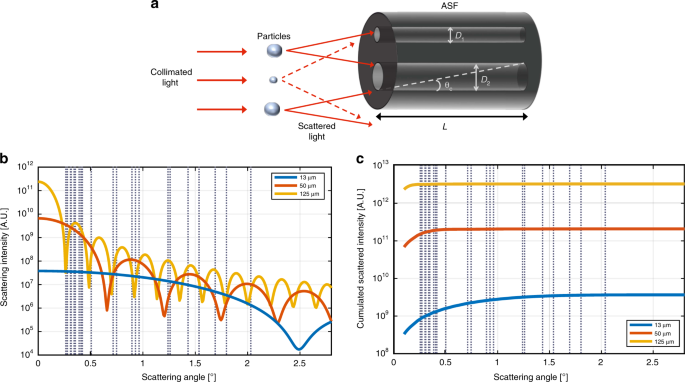Maximize Your Fiber Optic Efficiency: Recognizing Optical Fiber Size Analyser Modern Technology
The efficiency of fiber optic systems is critically influenced by the precision of their size, a variable commonly forgot in the pursuit of optimal signal integrity. Understanding the innovation behind optical fibre size analysers exposes the detailed balance between dimension precision and production top quality.
Relevance of Optical Fiber Diameter
The diameter of optical fibre plays an essential role in identifying the efficiency and performance of communication systems. Alternatively, smaller sized sizes often tend to sustain fewer settings, which can improve signal clarity and decrease crosstalk.

Furthermore, recognizing the diameter's effects can result in cost financial savings by reducing the need for signal amplification and repeaters in substantial networks (optical fibre diameter analyser). Finally, the relevance of optical fibre diameter can not be overstated, as it straight impacts the general performance and integrity of modern communication systems

Exactly How Diameter Impacts Signal Quality
Signal high quality in optical fibre systems pivots significantly on the diameter of the fiber. A smaller sized diameter can lead to greater attenuation prices, resulting in signal loss as light journeys via the fiber.
On the other hand, bigger diameters normally enable for boosted light capture and minimized modal dispersion, improving signal clarity. In multimode fibres, a bigger core size can sustain numerous light modes, however it might likewise present intermodal diffusion, which can deteriorate signal quality. As a result, picking the ideal fibre diameter is essential for attaining the wanted performance in specific applications.
Additionally, the interaction between the fibre size and the wavelength of the light utilized plays an essential function in establishing the reliable transmission distance and general signal stability. Therefore, recognizing how fibre size impacts signal high quality is important for network designers and engineers striving to enhance optical fibre systems for reputable, high-speed data transmission.
Review of Size Analyser Modern Technology
In many optical fibre production procedures, accurate dimension of fiber diameter is essential for making certain regular performance and top quality (optical fibre diameter analyser). Diameter analysers are sophisticated tools developed to examine the physical measurements of optical fibres with high accuracy. They use innovative optical and laser modern technologies to gauge the size, ovality, and concentricity of the fiber, hence giving crucial information for high quality control
These analysers can run in-line during the production process or as component of off-line testing methods. In-line systems make it possible for real-time monitoring, enabling suppliers to change specifications right away, thereby preserving ideal production problems. Off-line analysers, on the other hand, Visit Website supply comprehensive evaluations of sets, making sure that any discrepancies from specified tolerances are determined and addressed.
Size analysers significantly contribute to the reduction of issues in optical fibres, improving general item reliability. By regularly measuring key parameters, these innovations facilitate compliance with industry criteria and specifications. As the demand for high-performance optical fibers remains to rise, the duty of size analysers becomes increasingly essential in achieving the preferred high quality and efficiency criteria in fiber optic systems.
Key Attributes of Fiber Diameter Analysers
Although numerous models of fibre size analysers exist, they typically share numerous crucial features that improve their capability and reliability. One of one of the most significant attributes is high-resolution dimension capabilities, which make certain specific size readings, essential for keeping quality assurance in fibre production. Additionally, lots of analysers incorporate sophisticated optical sensing units developed to detect minute variations in fiber diameter, hence giving indispensable data for procedure optimization.
One more important function is real-time tracking, permitting drivers to receive instant feedback on fiber diameter throughout the production process (optical fibre diameter analyser). This ability assists in rapid adjustments and decreases the chance of problems. Many analysers also come outfitted with straightforward interfaces, allowing drivers to conveniently navigate through settings and information outcomes
Additionally, robust data storage and analysis performances are crucial for tracking historical performance fads and ensuring conformity with sector requirements. These attributes collectively contribute to the efficiency of fiber diameter analysers in enhancing fibre optic efficiency.
Finest Practices for Fibre Optimization

First, normal calibration of optical fiber size analysers is vital. This makes certain precise dimensions and reduces possible inconsistencies that might influence efficiency. Next off, maintaining a tidy functioning setting is important; dust and impurities can cause indicate degradation.
Furthermore, it is essential to pick fibers that satisfy particular application demands. This includes evaluating factors such as depletion, bandwidth, and environmental conditions. Proper installment strategies ought to additionally be abided by, including staying clear of sharp bends and too much tension, which can compromise fibre honesty.
In addition, using innovative surveillance systems can help with real-time efficiency evaluations, making it possible for prompt identification of problems. Routine screening and maintenance should be conducted to make certain that fibers continue to be within ideal functional criteria.
Lastly, training employees on published here the current fibre optimization modern technologies and approaches will certainly boost their capability to carry out efficient strategies. By following these best practices, organizations can dramatically enhance the performance and life-span of their optical fiber systems, ensuring efficient interaction and information transfer.
Verdict
In verdict, the integration of optical fibre diameter analyser technology is important for optimizing fiber optic efficiency. By making certain exact dimensions of fiber dimensions, these analysers dramatically boost signal quality and decrease losses during information transmission.
Signal top quality in optical fiber systems hinges dramatically on the diameter of the check that fibre.In numerous optical fiber manufacturing procedures, accurate dimension of fibre size is necessary for making certain regular efficiency and quality. As the demand for high-performance optical fibers continues to increase, the function of size analysers ends up being significantly essential in attaining the desired top quality and performance standards in fiber optic systems.
These functions jointly add to the efficacy of fiber diameter analysers in enhancing fibre optic performance.
In conclusion, the assimilation of optical fiber size analyser modern technology is crucial for making the most of fibre optic efficiency.